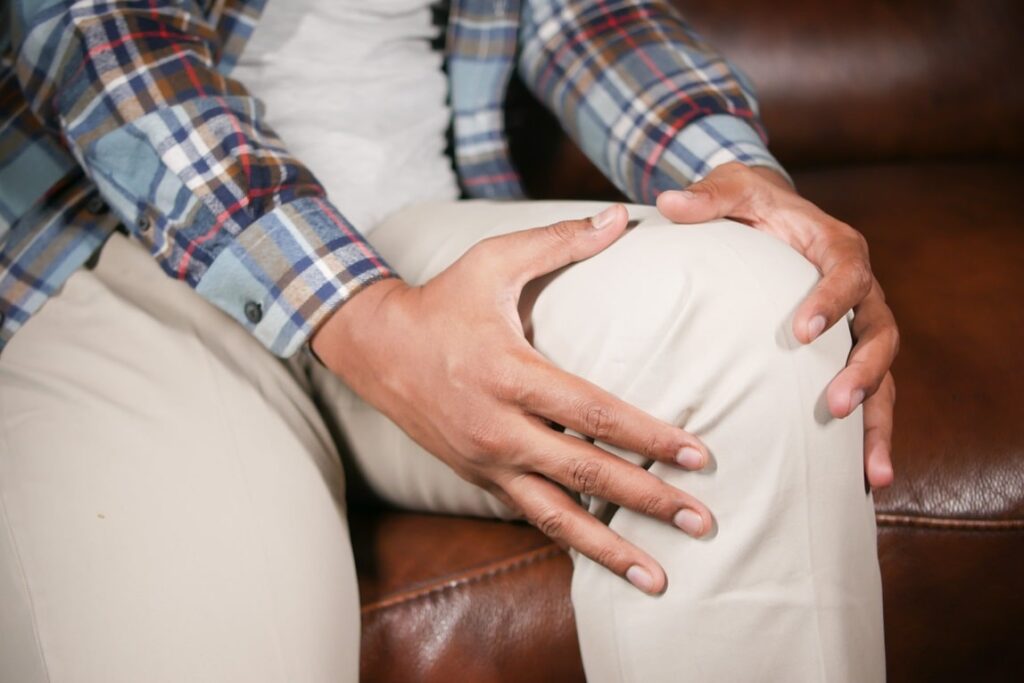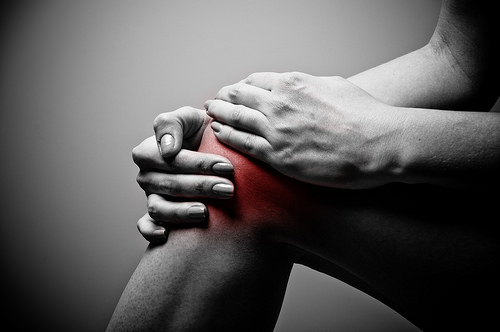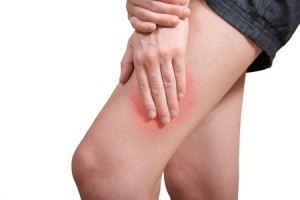Not All Leg Pain Is Sciatica

Houston Chiropractor Comments: The internet is a wonderful thing … if used correctly. New patients show up for their consultations and examinations at our Houston, Texas office with a wealth of healthcare knowledge that they have learned online. They can enter their symptoms online and a variety of health websites will diagnose their condition and give them a list of possible treatments.
This can work sometimes, but other times … not so well.
A common problem that I see is that all patients with leg pain assume that they have sciatica. Some have even been diagnosed by other doctors or therapists. Luckily, this is not the case.
Sciatica refers to pain that travels along the path of the sciatic nerve. The sciatic nerve travels from the buttocks and down each leg. Sciatica most often happens when a herniated disk or an overgrowth of bone puts pressure on the lumbar spine nerve roots. This happens “upstream” from the sciatic nerve.
An easy way to determine if it is sciatica or just referred pain from the lumbar spine or pelvis is if the pain radiates down past the knee. Only nerve pain will cross two joints, in this case the hip and knee. If the pain stops in the hamstring or the front of the thigh, it is not sciatica. Usually, the sciatic patient will present with a sharp pain on the outside of their calf.
Another aspect of sciatica is that it is typically only on one side. If the pain radiates down both legs, it is usually caused by some other condition.
If it is a mild case of sciatica, you can usually treat the condition by yourself with a combination of ice/heat, over-the-counter pain medication, and stretching. The stretches that I suggest can be found in the video I’ve shared below . Walking is also beneficial since it allows motion of the spine, pelvis, and legs. This allows the body to release endorphins and reduce inflammation.
If the sciatica is more severe or does not respond to the above treatment, I have noted while treating patients for 35 years in my Clear Lake City office, that proper chiropractic care gives the best and most lasting relief. With a careful examination and the correct chiropractic treatment, I have noticed that most patients have significant relief in 1-3 visits over a 1-week period-of-time and resolution of the complaint in 1-month.
Dr. Ward Beecher practices at Beecher Chiropractic Clinic at 1001 Pineloch, Ste 700 Houston, TX 77062. You can schedule an appointment at www.BeecherChiropractic.com or by calling (281) 286-1300. If you have any questions regarding this blog, please comment below!
Iliotibial Band Syndrome (ITBS)
Houston Chiropractor Comments: Periodically I will have patients who come in to the office with hip or knee pain that have not responded to typical medical care. X-rays or MRI’s do not show any degeneration of the joint or the cause of pain. Upon examination, it is determined that the pain is not coming from the joint, but instead it is originating in the iliotibial band (ITB).
The iliotibial band is a thickened portion of the tensor fascia latae (TFL) along its lateral aspect. The TFL attaches on the top of the pelvis and runs down the side of your leg to the knee. Pain is caused either from aggravation of the greater trochanteric bursa (for hip pain) or from rubbing on the outside of the knee joint (for knee pain).
Typically we see ITBS in patients who have increased their mileage in running, began using more stairs or being in a hilly area and in patients who are doing a lot of bike riding or spinning classes. The pain will increase with motion, either bending or straightening the leg out. Tenderness will be located along the outside of the thigh with the area above the knee usually the most tender.
The best treatment for ITBS is rest, ice, NASID’s, ultrasound, sports massage and rolling out the muscle with either a foam roller or rolling stick. The patient should also have their low back / pelvis, knee and ankle joints examined for alignment issues. Typically on patients with long standing ITBS the gait of the person has changed and the affected joints will need to be adjusted by a qualified chiropractor. After the problem has been addressed, the patient needs to keep the hip muscles stretched, strengthen the muscles on the outside of the hip and modify their training as to prevent a reoccurrence of the initial problem.
Dr. Ward Beecher practices at Beecher Chiropractic Clinic at 1001 Pineloch, Ste 700 Houston, TX 77062. You can schedule an appointment at BeecherChiropractic.com or by calling (281) 286-1300. If you have any questions regarding this blog, please comment below!

Oh, My Aching…Leg?
NASA Area Chiropractor Comments: Certain low back conditions give rise to more than just low back pain. For example, leg pain can be more intense than low back pain, even though the cause of the leg pain is coming from the low back. When this happens, many patients complain that they have “sciatica,” which refers to radiating pain that starts in the low back and extends down into the leg. When the intensity of leg pain is worse than the low back, it can make patients wonder, “…where is my problem really coming from?”

To understand this better, a short “anatomy lesson” is appropriate. The spine can be divided into two halves, front and back. The structures in the front half include the larger, heavier bones called vertebral bodies and the shock absorbing cushions that lie between the vertebral bodies called the intervertebral disks. The disk is like a jelly donut where the center is liquid-like and the outer portion is a tough, criss-cross pattern cartilage arranged like the rings on a tree stump. There are also ligaments that hold the vertebrae and disks tightly together. The back half of the spine includes the spinal cord, nerve roots, as well as the small joints of the back called facet joints. Every movable joint has a joint capsule that helps lubricate the joint and limits the amount of movement, along with surrounding ligaments. The larger, heavier vertebral bodies and shock absorbing disks carry the majority of the weight (approximately 80%) while the smaller facet joints carry much less weight (only 20%) but are more responsible for guiding the movements of our back.
When leg pain is present, it can be caused by either a pinched nerve, or, an inflamed facet joint.
When a nerve is pinched, the cause is usually from the intervertebral disk where the jelly-like center leaks out and presses on the nerve that goes down the leg, commonly referred to as a “herniated disk with sciatica.” This type of pain is quite specific, easy to describe and often extends below the knee to the ankle or foot. It can include muscle weakness, numbness in certain areas of the leg, and bending forward increases low back and leg pain while bending backwards reduces the leg pain (and sometimes the LBP).
When a facet joint capsule tears (technically, called a “sprain”), the pain is “referred” down the leg in a generalized, non-specific manner, usually described as a “deep ache,” often hard to describe and usually does not go below the level of the knee. Here, it feels better to bend forward and worse to bend backwards, of which neither movement changes or affects the leg in a specific way. Disk related leg pain carries a potential for surgery if all non-surgical approaches fail, while facet joint referred leg pain rarely requires invasive treatments or surgery.
The good news is that both of these sources of low back and leg pain are very treatable with chiropractic care! The important point to remember is that obtaining prompt treatment, when symptoms first appear is best – as waiting and hoping it will subside on its own often results in a longer treatment course and is less satisfying for all concerned.
Dr. Ward Beecher practices at Beecher Chiropractic Clinic at 1001 Pineloch, Ste 700 Houston, TX 77062. You can schedule an appointment at BeecherChiropractic.com or by calling (281) 286-1300. If you have any questions regarding this blog, please comment below!
Sciatica
To download a copy of this newsletter, please click here.
Sciatica
Houston Chiropractor Comments: The term sciatica describes the symptoms of leg pain—and possibly numbness, tingling or weakness—that originate in the lower back and travel through the buttock and down the large sciatic nerve in the back of the leg. It is a common complaint, with more than 3 million cases a year being reported.
- The large sciatic nerve is irritated or compressed in the lumbar spine.
- Sciatica is often characterized by one or a combination of the following symptoms.
- Constant pain in only one side of the buttock or leg (rarely can occur in both legs).
- Pain that is worse when sitting
- Leg pain that is often described as burning, tingling or searing (vs. a dull ache)
- Weakness, numbness or difficulty moving the leg or foot.
- A sharp pain that may make it difficult to stand up or to walk.
Sciatica type pain is usually caused by 6 main conditions. These conditions are lumbar herniated disc, degenerative disc disease, spondylolisthesis, lumbar spinal stenosis, piriformis syndrome and sacroiliac joint dysfunction.
Sciatica is typically self –limiting and will resolve itself with ice, stretching and light exercise. On cases that last more than 72 hours (3 days) the assistance of a doctor or trained therapist is beneficial. Conservative care is the most beneficial except in cases with loss of bowel or bladder function. Chiropractic care with spinal manipulation has been shown to have excellent results. Physical modalities can be added to assist in reducing the muscle spasms and inflammation. After the sciatica is resolved, a good stretching and strengthening program for the back is beneficial to help prevent a reoccurrence. If you have issues with your sciatica in Houston TX call me now.
Dr. Ward Beecher practices at Beecher Chiropractic Clinic at 1001 Pineloch, Ste 700 Houston, TX 77062. You can schedule an appointment at BeecherChiropractic.com or by calling (281) 286-1300. If you have any questions regarding this blog, please comment below!
Oh, My Aching…Leg? Sciatica Causes and Relief
 Clear Lake City, TX, Leg Pain & Sciatica Specialist: I have been practicing in Clear Lake City, Texas since 1990 and my patients are always surprised to learn that certain low back conditions give rise to more than just low back pain. For example, leg pain can be more intense than low back pain, even though the cause of the leg pain is coming from the low back. When this happens, many patients complain that they have “sciatica,” which refers to radiating pain that starts in the low back and extends down into the leg. When the intensity of leg pain is worse than the low back, it can make patients wonder, “…where is my problem really coming from?”
Clear Lake City, TX, Leg Pain & Sciatica Specialist: I have been practicing in Clear Lake City, Texas since 1990 and my patients are always surprised to learn that certain low back conditions give rise to more than just low back pain. For example, leg pain can be more intense than low back pain, even though the cause of the leg pain is coming from the low back. When this happens, many patients complain that they have “sciatica,” which refers to radiating pain that starts in the low back and extends down into the leg. When the intensity of leg pain is worse than the low back, it can make patients wonder, “…where is my problem really coming from?”
To understand this better, a short “anatomy lesson” is appropriate. The spine can be divided into two halves, front and back. The structures in the front half include the larger, heavier bones called vertebral bodies and the shock absorbing cushions that lie between the vertebral bodies called the intervertebral disks. The disk is like a jelly donut where the center is liquid-like and the outer portion is a tough, criss-cross pattern cartilage arranged like the rings on a tree stump. There are also ligaments that hold the vertebrae and disks tightly together. The back half of the spine includes the spinal cord, nerve roots, as well as the small joints of the back called facet joints. Every movable joint has a joint capsule that helps lubricate the joint and limits the amount of movement, along with surrounding ligaments. The larger, heavier vertebral bodies and shock absorbing disks carry the majority of the weight (approximately 80%) while the smaller facet joints carry much less weight (only 20%) but are more responsible for guiding the movements of our back.
When leg pain is present, it can be caused by either a pinched nerve, or, an inflamed facet joint.
When a nerve is pinched, the cause is usually from the intervertebral disk where the jelly-like center leaks out and presses on the nerve that goes down the leg, commonly referred to as a “herniated disk with sciatica.” This type of pain is quite specific, easy to describe and often extends below the knee to the ankle or foot. It can include muscle weakness, numbness in certain areas of the leg, and bending forward increases low back and leg pain while bending backwards reduces the leg pain (and sometimes the LBP).
When a facet joint capsule tears (technically, called a “sprain”), the pain is “referred” down the leg in a generalized, non-specific manner, usually described as a “deep ache,” often hard to describe and usually does not go below the level of the knee. Here, it feels better to bend forward and worse to bend backwards, of which neither movement changes or affects the leg in a specific way. Disk related leg pain carries a potential for surgery if all non-surgical approaches fail, while facet joint referred leg pain rarely requires invasive treatments or surgery.
The good news is that both of these sources of low back and leg pain are very treatable with chiropractic care in my office! The important point to remember is that obtaining prompt treatment, when symptoms first appear is best – as waiting and hoping it will subside on its own often results in a longer treatment course and is less satisfying for all concerned.
Dr. Ward Beecher practices at Beecher Chiropractic Clinic at 1001 Pineloch, Ste 700 Houston, TX 77062. You can schedule an appointment at BeecherChiropractic.com or by calling (281) 286-1300. If you have any questions regarding this blog, please comment below!


